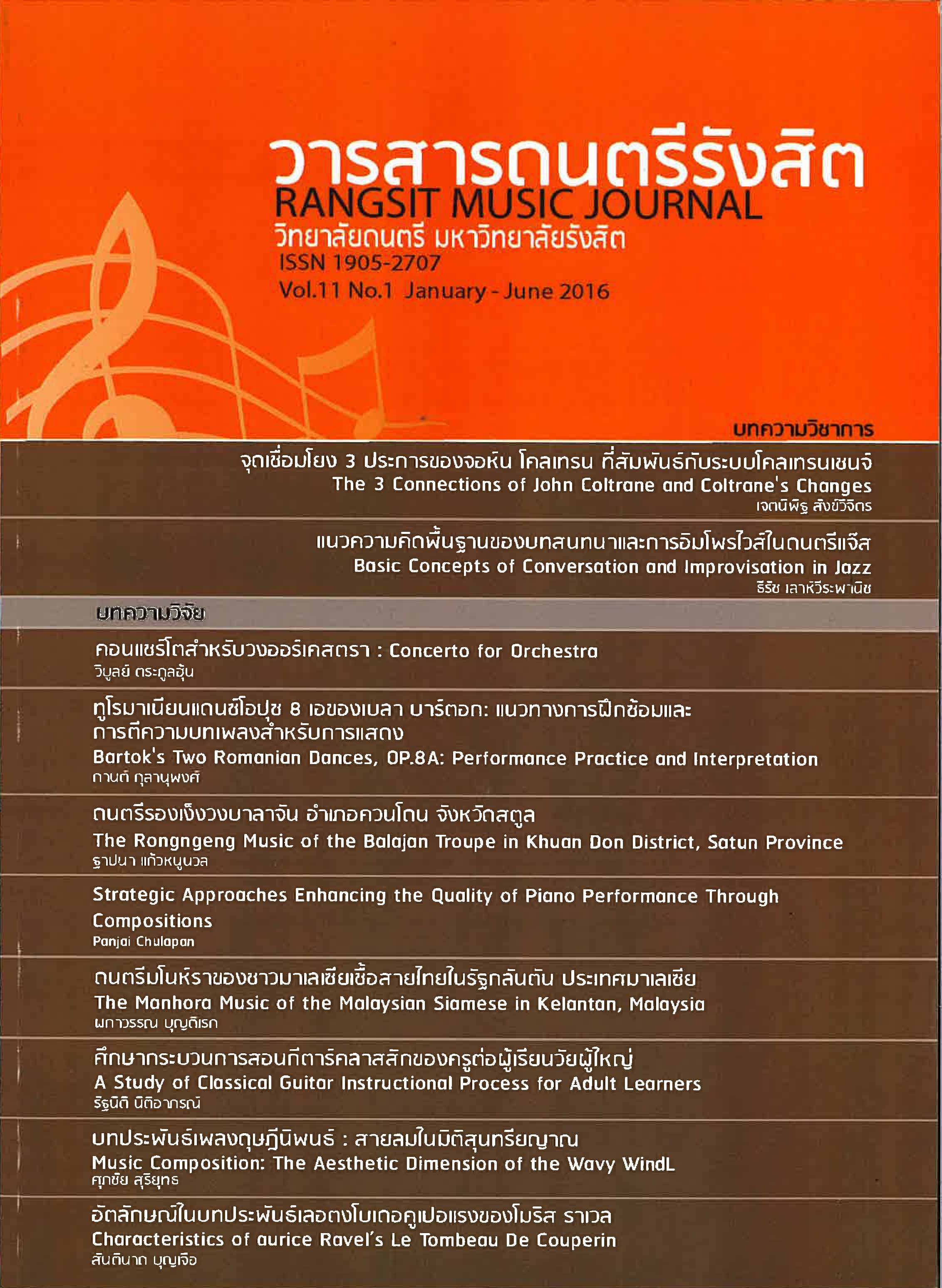The Manhora Music of the Malaysian Siamese in Kelantan, Malaysia
Abstract
This research is a qualitative research in ethnomusicology which is aim to 1) Study the general background of the Jung Kao Village, Tumpat Sub-district, Kelantan State of Malaysia 2) Study the Manhora and its music which are; historical background, performing elements, ensemble, musical instruments, and musicians 3) transcript the Manhora music into western notation. 4) Analyze the music in ethnomusicology methods. The research results were: 1) The Jung Kao Village, Tumpat Sub-district, Kelantan State of Malaysia is bordered to the north by Takbai District, Narathiwat Province, Thailand. Today the inhabitants, a number of about 400 of population, mostly are Buddhist and still maintain their cultural heritage from Thai ancestors. 2) The essential elements of Manhora performing comprise of the theater, the troupe, and the performers. The Manhora Seang ensemble, with 16 members, comprises of 8 instruments; Serunai, Tetawak, Canang, Gerduk, Gedombuk, Gendang, Ching and Crek. The ensembleMusic is an orally transmission which have been transmitted from generation to generation since the old time until today. It is found that the music nowadays is mainly performed for healing sickness as well as for ceremonies. The music, a pentatonic toneset comprises of 8 instruments; Serunai, Tetawak, Canang, Gerduk, Gedombuk, Gendang, Ching and Crek. 3) The music is transcript into western notation which comprise totally of 6 songs: Tangkhrueang, Kashkuru, Homrong, Nhoralongduean or Ploinangram, Panthon and Chapbot. These old songs, with unknown composers, mostly are strophic form in pentatonic toneset; D, F#,G, A and Bb, and ranged in between D4 and Bb5. The melodic contour are mostly undulating with some tied notes. It is found the repetition in some tunes. Among these songs, there are 27 styles of melodic rhythm. The three main tempos; free rhythm, slow, and fast, are found among the songs which are difference in rhythmic patterns of each percussion instruments.
References
2. กิตติศักดิ์ เหล่าสุข. "เพลงประกอบการแสดงโนห์ราและวัฒนธรรมที่เกี่ยวข้อง: กรณีศึกษามโนห์รา คณะสะพรั่ง สวีศิลป์." ปริญญานิพนธ์ศิลปกรรมศาสตรมหาบัณฑิต, มหาวิทยาลัยศรีนครินทรวิโรฒประสานมิตร, 2551.
3. คำนวณ นวลสนอง. ศึกษาพัฒนาการทางสังคมและวัฒนธรรมของชาติไทยในรัฐทางตอนเหนือของมาเลเซีย. กรุงเทพฯ: สำนักงานคณะกรรมการวัฒนธรรมแห่งชาติ ส่วนวิจัยและพัฒนาสถาบันวัฒนธรรมศึกษา, 2546.
4. ทวีศักดิ์ ล้อมลิ้ม. ความสัมพันธ์ระหว่างไทยกับมลายูในสมัยรัตนโกสินทร์ตอนต้น. กรุงเทพฯ: โรงพิมพ์เจริญรัตนการพิมพ์, 2516.
5. ธำรงศักดิ์ อายุวัฒนะ. ไทยในมาเลเซีย. พิมพ์ครั้งที่ 2. กรุงเทพฯ: โรงพิมพ์บรรณกิจ, 2531.
6. นิพนธ์ ทิพย์ศรีนิมิต. "ตัวตนทางวัฒนธรรมของคนไทยในรัฐทางตอนเหนือของประเทศมาเลเซีย." วิทยานิพนธ์ ปริญญาดุษฎีบัณฑิต, มหาวิทยาลัยมหาสารคาม, 2550.
7. ประทุม ชุ่มเพ็งพันธุ์. ศิลปวัฒนธรรมภาคใต้ ว่าด้วยภูมิศาสตร์ ประวัติศาสตร์ โบราณคดี ศิลปะ ภาษา วัฒนธรรม ประเพณีพื้นบ้าน ครบเครื่องเรื่องเมืองใต้. กรุงเทพฯ: สุวีริยาสาส์น, 2548.
8. Ismail, Mohammed Yusoff. Buddhism and Ethnicity Social Organization of a Buddhist Temple in Kelantan. Singapore: Institute of Southeast Asian Studies, 1983.
9. Peucell, Victor. Malaysia. London: Thames and Hudson Ltd London, 1965.
10. Roff, William R. Kelantan: Religion, Society and Politics in Malay State. Kuala Lumpur: Art Printing Works, 1974.
11. The Ministry of Foreign Affairs. Malaysia in Brief. Putrajaya: The Ministry of Foreign Affairs, 2000.







